

Whole-Tree Building: How to Craft Super-Natural Eco-Homes. The effect is astonishing: by using the natural shape of trees rather than milling them into dimensional lumber, the resulting architecture becomes organic and lifelike as if it were a living, breathing and growing structure – though correspondingly more difficult to construct, each custom branch and trunk needing to fit somehow in with the rest.
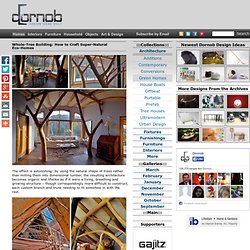
Aside from the breath-taking eco-aesthetic of his whole-tree houses and homes, Roald Gunderson‘s work has a number of benefits for the environment as well as a client’s pocketbook. Time, energy and money are saved by skipping the normal steps of processing raw wood into standard wooden structural sizes. Also, less carbon is released into the air and the naturally curved wood branches are stronger than their straight-and-narrow counterparts. (A) Futuristic, (B) Retro, (C) Organic or (D) Architecture. Bart Prince is a very hard architect to pin down – and he prefers it that way.

While some contemporary all-star architectural designers like Frank Gehry are known for signature styles and materials, Prince prefers to be inspired to create unique solutions for each site and situation. In discussion with Dornob, he noted that one of the highest forms of praise one can receive is when someone tells you they recognized something as your design because it looked unlike anything you have done to date. His inspirations include such ground-breaking architects as Antoni Gaudi, Frank Lloyd Wright and Bruce Goff – designers who diverged from the mainstream styles of their times. Looking at just a few works by Bart Prince can easily be misleading. One might take a snapshot from his career and be tempted to say they have figured him out, that he is “about curves” or “into strange forms” but around each corner is another work that is unlike any other.
Natural Architecture: Home-Grown Artistic Tree Houses. Patrick Dougherty is a builder and yet not an architect – he is perhaps best described as an artist and sculptor, a wood craftsman the likes of which most of us have never seen.
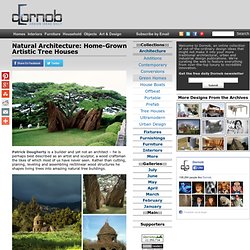
Rather than cutting, planing, leveling and assembling rectilinear wood structures he shapes living trees into amazing natural tree buildings. What started as simple arbosculptures quickly become inhabitable spaces and entire built environments. Some of the results seem like churches or gazebos, religious or resting places deep in the forest, as shown in the pictures above. Others are more abstract and open for interpretation or mixed-use occupation, changing with seasonal conditions as shown below. Always temporary by necessity, he grows and shapes the constituent sapplings to create playful and interactive forms in all kinds of contexts (with over 150 installations worldwide to date).
Auroville, a universal city in the making. China to Build First Eco-City. Jean-Pierre Langellier and Brice PedrolettiGuardian Weekly Imagine it is 2010.
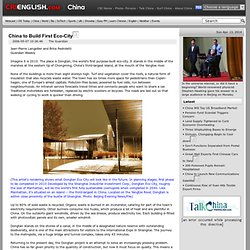
The place is Dongtan, the world's first purpose-built eco-city. It stands in the middle of the marshes at the eastern tip of Chongming, China's third-largest island, at the mouth of the Yangtse river. None of the buildings is more than eight storeys high. Turf and vegetation cover the roofs, a natural form of insulation that also recycles waste water. (This artist's rendering shows what Dongtan Eco City will look like in the future. Up to 80% of solid waste is recycled. Dongtan stands on the shores of a canal, in the middle of a designated nature reserve with outstanding biodiversity, and is one of the main attractions for visitors to the international Expo in Shanghai. Returning to the present day, the Dongtan project is an attempt to solve an increasingly pressing problem.
The contract for the project was awarded to the Shanghai Industrial Investment Corporation (SIIC) seven years ago. Living Grass Walls Completely Cover the Interior of London's Dilston Grove Gallery! Acclaimed British artists Heather Ackroyd & Dan Harvey recently transformed a landmark church in South East London by completely covering its interior in a layer of living grass!
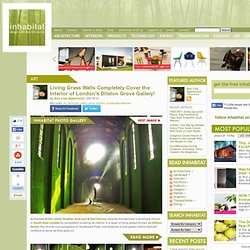
Known as Dilston Grove, the church-cum-art-gallery in Southwark Park, now features a lush green interior that will continue to grow as time goes on. Dilston Grove — formerly known as Clare College Mission Church — is an Italian-style Grade II Listed Building that dates back to 1900. In the 1960s it was converted into a series of artist studios, and now it’s one of South East London’s hidden art world gems. The gallery’s melancholic atmosphere has now been lifted up by Ackroyd & Harvey’s sprouting grass interiors. Temptation. Every so often an email lands in my inbox from perhaps the cruelest man I know.
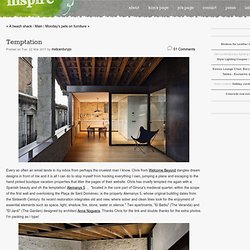
Chris from Welcome Beyond dangles dream designs in front of me and it is all I can do to stop myself from hocking everything I own, jumping a plane and escaping to the hand picked boutique vacation properties that litter the pages of their website. Chris has cruelly tempted me again with a Spanish beauty and oh the temptation! Alemanys 5 ... "located in the core part of Girona's medieval quarter, within the scope of the first wall and overlooking the Plaça de Sant Domènec, is the property Alemanys 5, whose original building dates from the Sixteenth Century. Its recent restoration integrates old and new, where sober and clean lines look for the enjoyment of essential elements such as space, light, shadow, fire, stone, water or silence. "